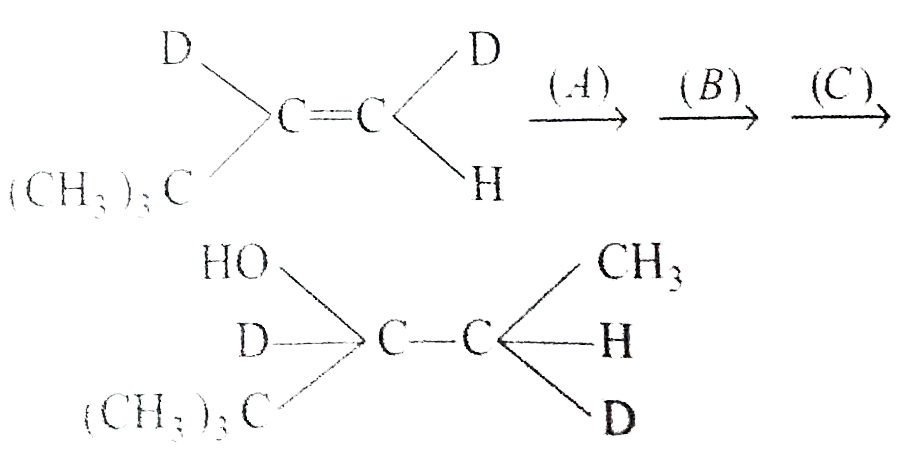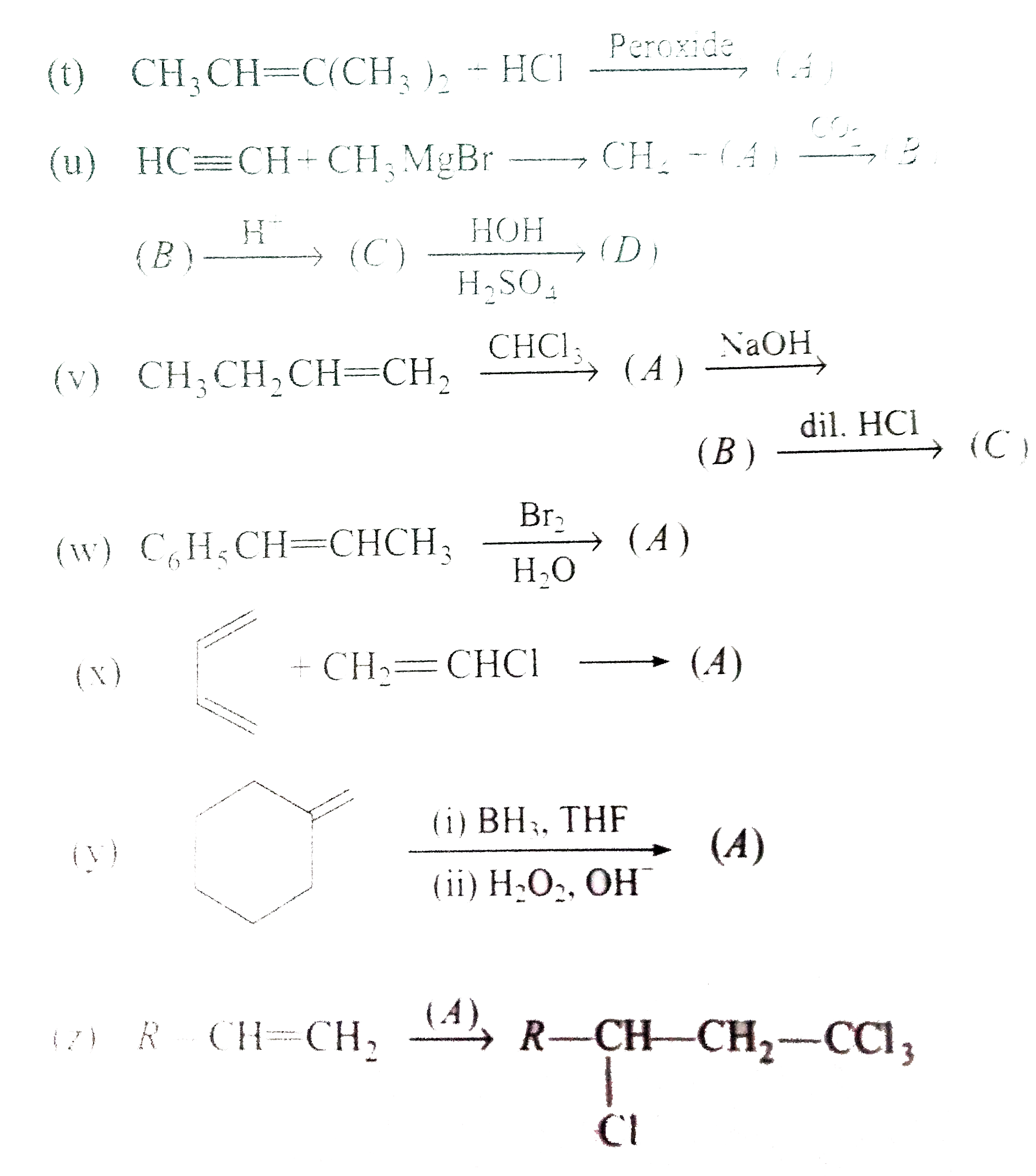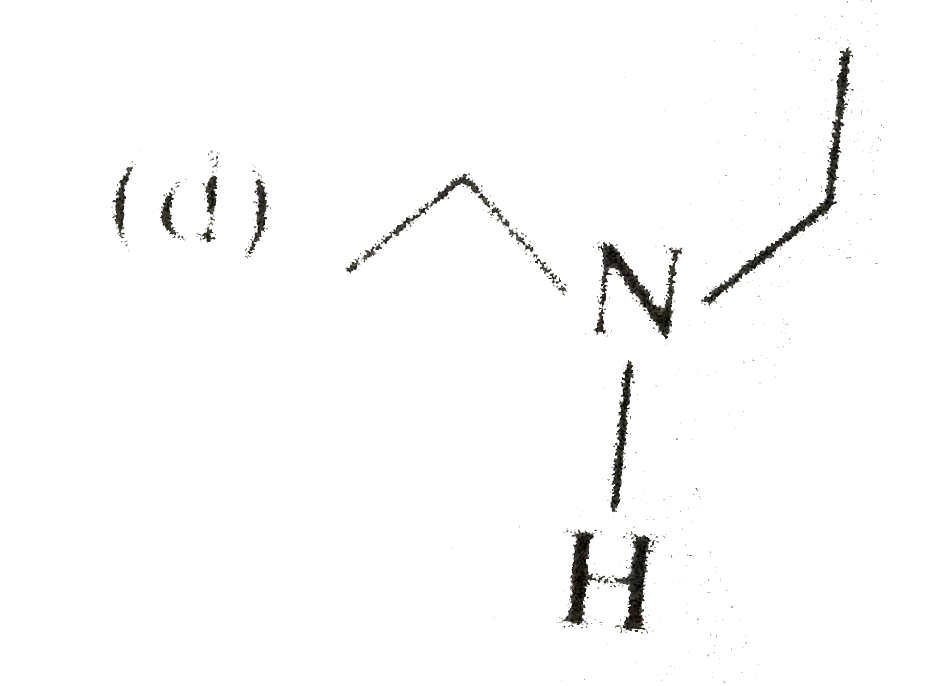H−C≡C−H+2NaNH2→A2 mole−−−→CH3ClB
then 'B' is
1 - Butyne
2 - Butyne
2 - Pentyne
Propyne
The correct Answer is:B
To solve the given question step by step, we will analyze the reactions taking place and determine the final product 'B'.
Step 1: Identify the starting compound
The starting compound is H-C≡C-H, which is ethyne (acetylene).
Step 2: Reaction with NaNH₂
When ethyne reacts with 2 moles of NaNH₂, the sodium amide (NaNH₂) acts as a strong base. It abstracts a proton (H⁺) from the terminal carbon of ethyne, resulting in the formation of a carbanion (negatively charged carbon).
The reaction can be represented as:
H-C≡C-H+NaNH2→H-C≡C−Na++NH3
Step 3: Formation of the carbanion
The carbanion formed is H-C≡C⁻. The negative charge on the carbon is stabilized due to its sp hybridization.
Step 4: Reaction with CH₃Cl
Next, the carbanion reacts with 2 moles of CH₃Cl. The carbanion acts as a nucleophile and attacks the electrophilic carbon in CH₃Cl, displacing the chloride ion (Cl⁻).
The reaction can be represented as:
H-C≡C−+CH3Cl→H-C≡C-CH3+Cl−
Step 5: Repeat the reaction
Since we have 2 moles of NaNH₂ and CH₃Cl, we can repeat the above reaction. The carbanion formed in the previous step can again react with another mole of CH₃Cl.
The second reaction is:
H-C≡C-CH3+CH3Cl→CH3C≡C-CH3+Cl−
Step 6: Final product
After both reactions, the final product 'B' is CH₃C≡CCH₃, which is 2-butyne.
Conclusion
Thus, the final product 'B' is 2-butyne.
---
The starting compound is H-C≡C-H, which is ethyne (acetylene).
When ethyne reacts with 2 moles of NaNH₂, the sodium amide (NaNH₂) acts as a strong base. It abstracts a proton (H⁺) from the terminal carbon of ethyne, resulting in the formation of a carbanion (negatively charged carbon).
H-C≡C-H+NaNH2→H-C≡C−Na++NH3
The carbanion formed is H-C≡C⁻. The negative charge on the carbon is stabilized due to its sp hybridization.
Next, the carbanion reacts with 2 moles of CH₃Cl. The carbanion acts as a nucleophile and attacks the electrophilic carbon in CH₃Cl, displacing the chloride ion (Cl⁻).
H-C≡C−+CH3Cl→H-C≡C-CH3+Cl−
Since we have 2 moles of NaNH₂ and CH₃Cl, we can repeat the above reaction. The carbanion formed in the previous step can again react with another mole of CH₃Cl.
H-C≡C-CH3+CH3Cl→CH3C≡C-CH3+Cl−
After both reactions, the final product 'B' is CH₃C≡CCH₃, which is 2-butyne.
Thus, the final product 'B' is 2-butyne.
Topper's Solved these Questions
- BOOK - NARAYNACHAPTER - HYDROCARBONS EXERCISE - EXERCISE - 2 (H.W) (PREPARATION & PROPERTIES)5videos
HYDROCARBONS
- BOOK - NARAYNACHAPTER - HYDROCARBONS EXERCISE - EXERCISE - 325videos
HYDROCARBONS
- BOOK - NARAYNACHAPTER - HYDROCARBONS EXERCISE - EXERCISE - 2 (H.W) (ALKENES) (PREPARATIONS OF ALKENES)2videos
HYDROCARBONS
- BOOK - NARAYNACHAPTER - GENERAL ORGANIC CHEMISTRYEXERCISE - Matrix-Match type questions7videos
GENERAL ORGANIC CHEMISTRY
- BOOK - NARAYNACHAPTER - HYDROGEN & ITS COMPOUCDSEXERCISE - Interger type questions10videos
HYDROGEN & ITS COMPOUCDS
Similar Questions
Complete the following reactions
_S01_429_Q01.png)
_S01_429_Q02.png)
(c ) CH3CH=CH2mCPBA−−−−→AC2H5MgBr−−−−−−→H3O+BView SolutionComplete the following equations:
a) H2C=CH−CH3+HCl→(A)
b) CH3−CH=C(CH3)2+O3Zn−−→H2O(A)+(B)
c) H2C=CH2+O3H2O−−→(A)NaOH(aq)−−−−−−→(B)+(C)
d) (CH3)3C−CH=CH2+HC<o(A)
d) MeCH2C≡CHNaNH2−−−−→(A)Et.Br−−−→(B)
g) HC≡CHH2,Pd(CaCO3)−−−−−−−−−−→(CH3COO)2Pb(A)Br2−−→Cl4(B)KOH(alc)−−−−−−→(C)
h) HC≡CHHgSO4,H2O−−−−−−−→H2SO4(A)H−−−→LiAlH4(B)concH2SO4−−−−−−→443K(C)
i) CH3CH=(CH2)Br2A773KCl2−−→773K(B)
j) CH3CH=CH2Br2−−→773K(A)KOH(alc)−−−−−−→Δ(B)
k) H2C=CH2+CH2+CH2→(A)
l) CH3CH=CH2+CH2I2→(A)
m) H2C=CH−CH=CH2+H2=CH2→(A)H2−−→Pd(B)
n) C3H7CH=CH2Hg(OAc)2−−−−−−→THF/H2O(A)NaBH4/NaOH−−−−−−−−−→(B)
o) CH3CH=CH2BH3/THF−−−−−−→(A)CH3COOH−−−−−−→(B)
p) C6H5CH=CH2Br2−−→(A)3.0equiv−−−−→CH3I(B)
q) C6H5CH2CH(Cl)C6H5KOH(alc)−−−−−−→Δ(A)
r)
 View Solution
View Solution
Knowledge Check
- Question 1 - Select One
H−C≡C−H+NaNH2→A2 mole−−−→CH3ClB Then B is
A1-ButyneB2-ButyneC2-PentyneDPropyne - Question 2 - Select One
HC≡CHExcessNaNH2−−−−→AC2H5Cl−−−−→B find the B.
AC2H5≡C−C2H5BHC≡C−C2H5CH2C=CH−C2H5DClHC=CHC2H5 - Question 3 - Select One
CH3CH2BrAgCN−−−→ANaOH,Δ−−−−−→⊕H3OB,(B) is:
ACH3CH2NHCH3BCH3CH2CH2NH2CCH3CH2NH2D
Consider the following reaction sequence,
CH3C≡CHaq.H2SO4−−−−−→H2SO4APCI5−−→HeatB
The products (A) and (B) are, respectively,View SolutionCH3CH∣CH3−CH=CH2(i)B2H4−−−−−−−−−→(ii)H2O2/OHXH2SO4−−−→140∘Y
What is Y ?View SolutionIn the transformations
PhCH=CH2ArCO3H−−−−−−→CH2Cl2A1.LiAlH4,Et2O−−−−−−−−−−→2.H2OB
The end product (B) isView SolutionIn the reaction
H−C=C−HNaNH2−−−−→ACH3l−−→BHg2+−−−→H3O+C
the final product 'C' is :View SolutionIn the reaction H−C≡CH(1)NaNH2/liq.NH3−−−−−−−−−−−−−→(2)CH3CH2BrX,(i)NaNH2/liq.NH3−−−−−−−−−−−−−→(2)CH3CH2BrY
X and Y are :View Solution

